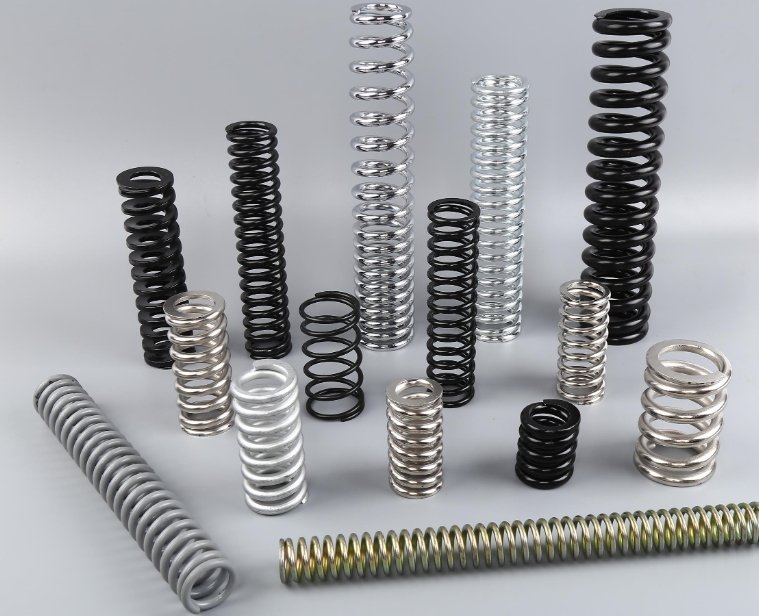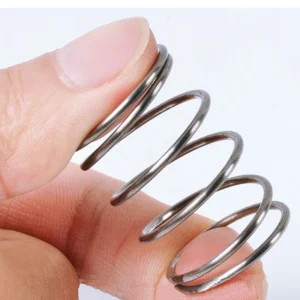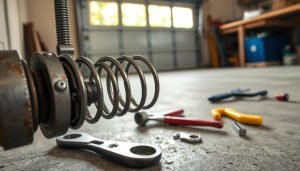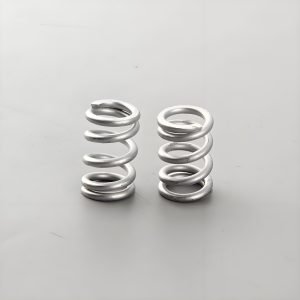The material a spring is made of has a significant impact on how it will behave both under load and in its operational environment. Regarding strength, conductivity, heat resistance, and resistance to corrosion, various metal materials differ in their respective advantages and disadvantages. This post will offer you with a detailed analysis of the benefits and drawbacks of different spring metal materials, as well as a comparison chart to make it easier for you to select the best spring material for your particular requirements.
Highly Carbon Steel Springs: Economical and Frequently Utilized
Benefits
High Strength: Compared to low carbon steel, high carbon steel, which has a carbon content of between 0.6% and 1.0%, is stronger and more resilient, making it a good choice for applications requiring high strength.
Economical: Springs made of high carbon steel are reasonably priced and perfect for producing a wide range of general-purpose mechanical devices.
Drawbacks:
Poor corrosion resistance: Additional protection measures are typically needed since high carbon steel springs are prone to rusting in humid or corrosive situations.
Temperature sensitivity: The material’s strength may diminish at high temperatures.
Examples of Applications: Compression springs in mechanical equipment and high carbon steel springs are commonly utilized in vehicle suspension systems.
Stainless steel springs are ideal for severe situations due to their exceptional resistance to corrosion.
Benefits
Exceptional resistance to corrosion: When exposed to air or water, stainless steel’s chromium content creates a protective oxide coating that wards off rust.
Good performance at high temperatures: Stainless steel is resistant to breaking down and may retain its strength at high temperatures.
Drawbacks:
Costlier: The materials used to make stainless steel springs are more costly, particularly when premium stainless steel (such as 316 or 17-7 PH alloy) is needed.
Little lower elastic modulus: Compared to high carbon steel, stainless steel has a little lower elastic modulus, which could have an impact on the spring’s performance in specific situations.
Examples of applications: Springs made of stainless steel are frequently found in equipment used in food processing, medical devices, and other settings where corrosion prevention is necessary.
Alloy steel springs: Proficient in handling elevated tension
Benefits
High strength and durability: Chrome silicon steel and other alloy steel spring materials may continue to perform admirably even under extreme stress, making them ideal for applications requiring fatigue and impact resistance.
Good resistance to high temperatures: Alloy steel is resistant to temperature changes and may retain its mechanical qualities at high temperatures.
Drawbacks:
Greater expense: The cost and complexity of processing make alloy steel spring materials more expensive than regular high carbon steel.
Moderate corrosion resistance: Alloy steel is nevertheless susceptible to corrosion in very corrosive situations, although being more resistant than high carbon steel. Additional protection is necessary.
Examples of applications: springs made of alloy steel are frequently found in car suspension systems, aircraft parts, and important heavy machinery parts.
Alloy springs made of copper: the perfect balance of corrosion resistance and conductivity
Benefits
Good conductivity: Alloys based on copper, like phosphor bronze and beryllium copper, are perfect for electrical applications because of their exceptional electrical conductivity.
Non-magnetic: In situations where non-magnetic materials are required, alloy springs made of copper work perfectly.
Excellent resistance to corrosion: Copper alloys work well in a variety of hostile conditions and are appropriate for humid or corrosive settings.
Drawbacks:
Weakness: Copper-based alloys are not appropriate for high-load applications due to their lower strength and elastic modulus when compared to steel.
High cost: Materials for copper alloys, particularly high-purity beryllium copper, are typically pricey.
Examples of Applications: Electrical switches, relays, and battery contacts are just a few of the electrical applications that frequently use copper-based alloy springs.
Alloy springs based on nickel: Effective solutions for harsh conditions
Benefits
Extremely high heat resistance: Alloys based on nickel, including Inconel and Hastelloy, are appropriate for settings with extremely high temperatures because they can withstand high temperatures without losing strength.
Superior resistance to corrosion: Alloys based on nickel have the ability to preserve its structure even in the most harsh chemical conditions, which makes them perfect for extremely corrosive settings.
Drawbacks:
Exorbitant: Due to their high cost and processing complexity, alloys based on nickel are mostly utilized in applications where exceptionally high performance is required.
Complex processing: Special tools and methods are needed for processing since nickel-based alloys have a high strength and resistance to corrosion.
Examples of Applications: Aircraft parts, heavy industrial parts, and nuclear power plant equipment are among the many applications for nickel-based alloy springs.
Comparison table of advantages and disadvantages of various spring materials
| Type | Advantages | Disadvantages | Application Fields |
|---|---|---|---|
| High Carbon Steel Spring | High strength, low cost | Poor corrosion resistance, poor high-temperature performance | Automotive suspension, general machinery |
| Stainless Steel Spring | Good corrosion resistance, good high-temperature performance | High cost, slightly lower modulus of elasticity | Medical devices, food processing equipment |
| Alloy Steel Spring | High strength, high-temperature resistance, fatigue resistance | High cost, moderate corrosion resistance | Aerospace, heavy machinery |
| Copper Alloy Spring | Good conductivity, non-magnetic, corrosion resistant | Low strength, high cost | Electrical equipment, switches, relays |
| Nickel Alloy Spring | High-temperature resistance, excellent corrosion resistance | Very high cost, complex processing | Nuclear power equipment, aerospace components |
Each spring material has benefits of its own, and the best option will rely on the demands of your particular application. A spring with exceptional strength and longevity might be best made of alloy or high carbon steel. Alloys based on nickel or stainless steel are better options if corrosion resistance is a requirement for your application. Alloys based on copper are perfect for electrical applications that need electrical conductivity.
It’s crucial to take the demands of the particular application, performance, and price into account when selecting a spring material. Richconn Spring offers the knowledge and skills to assist you in choosing and modifying the ideal spring material for your particular requirements. Reach out to our engineering team for expert guidance and solutions to elevate your design!






